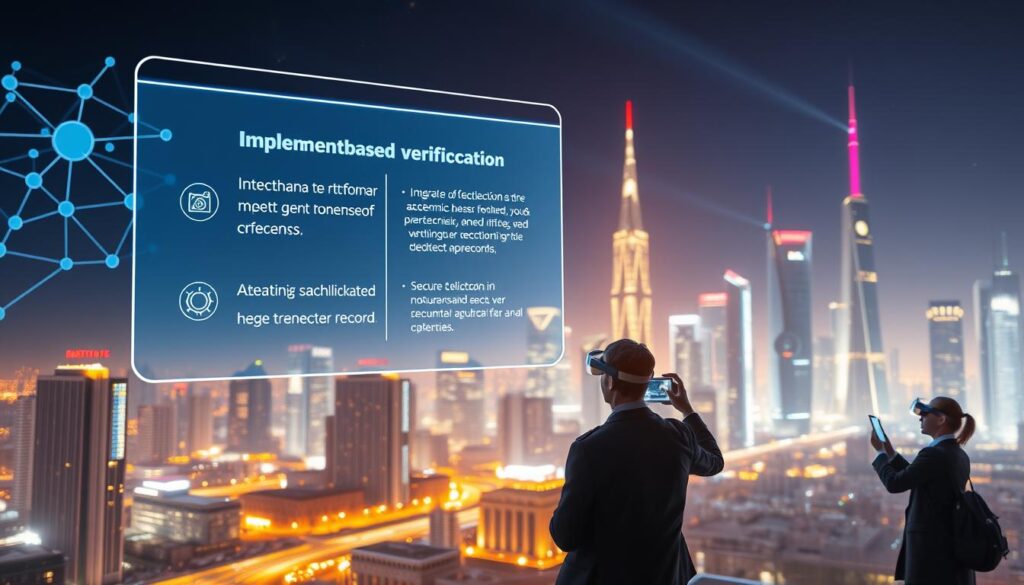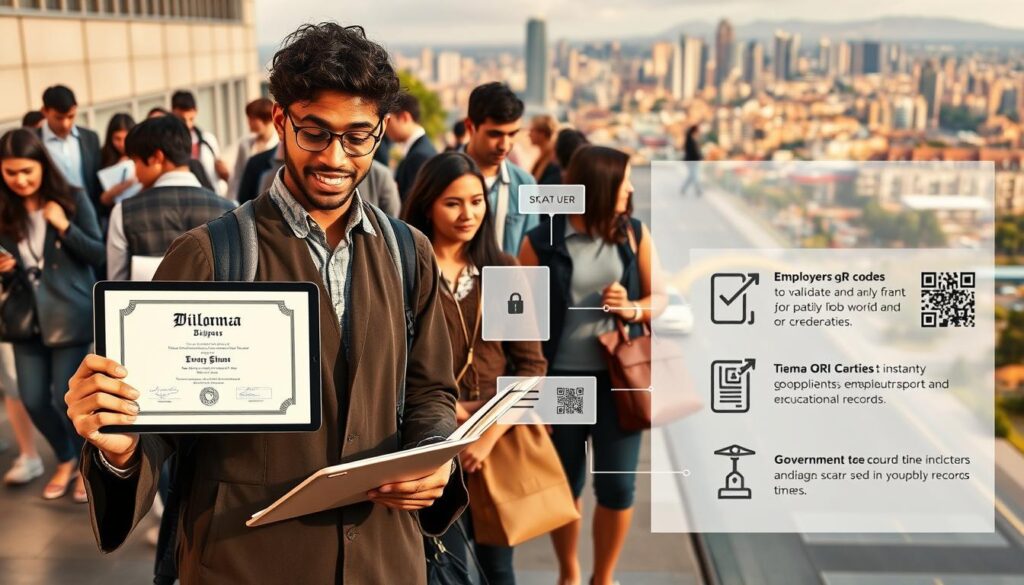Now Reading: How Blockchain in Education Credential Verification Works
- 01
How Blockchain in Education Credential Verification Works
How Blockchain in Education Credential Verification Works

Every year, millions of graduates face a common hurdle: proving their academic achievements. They often get lost in a sea of paperwork. Employers and universities frequently question the authenticity of traditional documents.
The global market for digital proof of qualifications is booming. It is projected to reach $1.13 billion by 2026. This growth highlights a massive shift away from paper-based systems.
This new approach uses a secure, decentralized digital ledger. It creates a permanent and unchangeable record for academic awards. This technology tackles the long-standing issues of fraud and administrative delays head-on.
The solution benefits everyone involved. Students gain control over their records. Institutions and employers enjoy a faster, more reliable verification process. This introduction sets the stage for understanding this transformative system.
Key Takeaways
- The traditional system for verifying academic qualifications is often slow and unreliable.
- A new digital approach is revolutionizing how we manage and trust educational records.
- The global market for digital credentials is experiencing rapid, billion-dollar growth.
- This technology provides a secure, tamper-proof method for storing achievements.
- It addresses critical challenges like fraud and inefficiency for all stakeholders.
- The system makes credential verification faster and globally accessible.
- This article will explain how the process works and its real-world benefits.
Introduction: The Need for a New Credential Verification System
The current framework for validating academic achievements is fundamentally broken. Studies reveal that up to 40% of job applicants misrepresent their qualifications. Yet, only about half of employers consistently check these documents.
This gap has fueled a massive industry of fake degrees. The market exploded from $1 billion in 2015 to a staggering $22 billion in 2022. Billions of fraudulent diplomas are now in global circulation.
Traditional confirmation is a slow, multi-step ordeal. It involves schools, companies, and third-party services. This process can take days or even weeks, causing frustrating delays for graduates.
Paper records and early digital systems are easy to tamper with or lose. Manual handling creates a heavy burden for university staff. It pulls resources away from core teaching and research activities.
A major hurdle is the lack of uniform standards. Different institutions and countries use various formats. This lack of uniformity makes cross-border recognition complex and error-prone.
These inefficiencies lead to high costs, especially for employers hiring at scale. Sharing sensitive records with multiple parties also raises serious data privacy concerns. With international student numbers expected to soar, the need for secure, efficient systems has never been greater. Exploring new digital methods is becoming essential.
Blockchain in Education Credential Verification: Enhancing Security and Trust
Security and trust are fundamentally rebuilt through a combination of advanced cryptography and decentralized record-keeping. This system creates a permanent, unchangeable ledger for academic achievements.
The process starts when an institution issues a digital certificate. This information is converted into a unique digital fingerprint, or hash. Even a tiny change to the original document creates a completely different hash.

This hash is stored on a distributed ledger. Each new entry is cryptographically linked to the previous one. This chaining effect makes altering past records practically impossible.
Verification uses a public/private key system. The issuer signs the credential with a private key. Anyone can then validate its authenticity using the corresponding public key, without seeing sensitive data.
The decentralized nature removes single points of failure. There is no central database to hack. This structure, as explored in research on secure systems, builds immense trust among all parties.
| Feature | Paper Certificates | Basic Digital Files | Blockchain-Based System |
|---|---|---|---|
| Tamper Resistance | Low | Medium | Extremely High |
| Permanence | Vulnerable to loss/damage | Depends on server uptime | Permanent and global |
| Verification Speed | Days or weeks | Minutes to hours | Instant |
| Intermediaries Needed | Multiple | Often one (issuer) | None |
This method establishes a new standard for security. It ensures that qualifications remain trustworthy and easily confirmable throughout a person’s career.
Implementing Blockchain Credential Systems: A Step-by-Step Guide
Adopting new methods for managing qualifications requires careful planning and a clear implementation roadmap. Most universities choose a hybrid approach that balances transparency with privacy concerns.

Issuance and Digital Signatures
The process begins when schools create digital certificates. Each record receives a unique identifier and cryptographic signature. This creates an unbreakable link between the institution and the qualification.
Decentralized Storage and Verification
Records are stored across multiple nodes, preventing unauthorized changes. Students control access through private keys or digital wallets. Employers can instantly confirm authenticity without intermediaries.
Leveraging Smart Contracts for Automation
Automated contracts handle tasks like degree issuance and eligibility checks. This reduces administrative workload significantly. The technology ensures consistent application of institutional policies.
| Phase | Duration | Key Objectives | Success Metrics |
|---|---|---|---|
| Pilot Program | 6 months | Test 3-5 credential types | User acceptance >85% |
| Regional Scaling | 12-18 months | Connect multiple institutions | Verification under 10 seconds |
| Global Adoption | 24+ months | Cross-border compatibility | Under 5-second verification |
This structured approach ensures smooth transition from traditional methods. It maintains data security while improving accessibility for all stakeholders.
Real-World Applications and Stakeholder Benefits
Leading universities are demonstrating tangible results from adopting new verification technologies. These systems deliver measurable advantages across the entire academic ecosystem.

Academic and Professional Impact
Institutions like MIT Media Lab and Georgia Institute of Technology show what’s possible. They report 75% faster verification compared to manual systems.
Students gain immediate access to their digital qualifications. They can share these records securely with potential employers worldwide. This eliminates the frustration of lost paper certificates.
Professionals build comprehensive career portfolios. These include certifications from organizations like the Global Skill Development Council. The result is a portable, always-accessible record of achievements.
Employer Advantages in Hiring and Verification
Hiring managers benefit significantly from these innovations. 92% of employers prefer instant digital validation over traditional methods.
The verification process becomes nearly instantaneous. This replaces weeks-long manual checks. Companies also eliminate risks associated with fraudulent qualifications.
Over half of hiring managers now prioritize academic confirmation in recruitment. This shows strong demand for reliable verification solutions.
Institutional Efficiency and Cost Reduction
Universities achieve substantial operational improvements. They report 60% lower administrative costs for credential management.
Automated systems can issue hundreds of qualifications in minutes. This saves printing, postage, and storage expenses. Staff can focus more on teaching and research activities.
Institutions using these technologies see 30% fewer fraud cases. They also achieve 40% higher user satisfaction rates. This positions them as innovative leaders in higher education.
Addressing Traditional Challenges in Credential Verification
Traditional methods for confirming qualifications face three fundamental obstacles that undermine their effectiveness. These issues affect students, institutions, and employers across the global landscape.

Combating Fraud and Forgery
Document falsification represents a serious threat to many sectors. Up to 40% of applicants misrepresent their academic background.
The fake degree market exploded to $22 billion recently. New systems can reduce fraudulent activities by up to 78%.
Streamlining Inefficient Processes
Manual confirmation often takes weeks and involves multiple intermediaries. This creates unnecessary delays and increased costs.
Automated solutions slash verification expenses by 65%. They provide instant confirmation instead of lengthy waiting periods.
Ensuring Data Privacy and Global Interoperability
Privacy concerns arise when sharing sensitive academic information. Advanced cryptographic techniques allow selective disclosure of necessary details.
Global standards enable cross-border recognition of qualifications. Future-proof systems will maintain security for over a century.
| Challenge Area | Traditional System | Advanced Solution |
|---|---|---|
| Fraud Prevention | Limited detection capability | Near-elimination of forgery |
| Processing Time | Weeks for confirmation | Instant verification |
| Cost Efficiency | High administrative expenses | 65% reduction in costs |
| Data Protection | Vulnerable to breaches | Advanced privacy features |
| Global Compatibility | Inconsistent standards | Cross-border interoperability |
Conclusion
The shift toward digital academic records marks a pivotal moment for all stakeholders. This innovative system offers students full control over their lifelong achievements. It provides a secure and portable solution for sharing qualifications.
For universities, the benefits are substantial. They report 75% faster verification and 60% lower administrative costs. This technology also drastically reduces fraud cases, enhancing institutional trust.
Employers gain immediate, trustworthy confirmation during hiring. This streamlines their recruitment processes significantly. The move away from paper-based methods is clearly accelerating.
This approach represents a fundamental transformation in managing academic proof. It builds a more efficient and reliable global framework for recognizing achievements. The future of academic records is undoubtedly digital, secure, and instantly verifiable.
FAQ
What is the main problem with traditional systems for checking qualifications?
The main issue is that old-fashioned methods often rely on paper certificates or centralized databases that can be slow and vulnerable to fraud. This makes it hard for employers and institutions to quickly and confidently confirm a person’s academic or professional history.
How does this new technology improve security for academic records?
It creates a tamper-proof, decentralized ledger. Once a university like MIT or a certification body issues a qualification, it is cryptographically sealed. This makes altering or forging documents virtually impossible, greatly increasing trust for all parties involved.
Who has control over the data in this type of system?
Students and job seekers retain full control over their own records. They can grant permission to employers, such as Google or a local school district, to view their verified credentials without needing to contact the original issuing institution, putting ownership back in the hands of the individual.
What are the benefits for employers during the hiring process?
Employers experience significant gains in efficiency. They can instantly verify a candidate’s degrees or professional certificates directly through a secure, trusted system. This reduces hiring time, cuts administrative costs, and minimizes the risk of hiring someone with fraudulent qualifications.
Can this technology work with existing university record systems?
Yes, integration is a key focus. Solutions are designed to work alongside current student information systems used by institutions. This allows for a smoother transition, where digital credentials can be issued in parallel with traditional paper documents, enhancing processes without a complete overhaul.
How does this approach protect an individual’s privacy?
Privacy is a core principle. Instead of storing personal data on a public ledger, the system typically uses a unique digital fingerprint (hash) of the credential. This means sensitive information remains private, while still allowing anyone with permission to verify its authenticity against the secure record.














